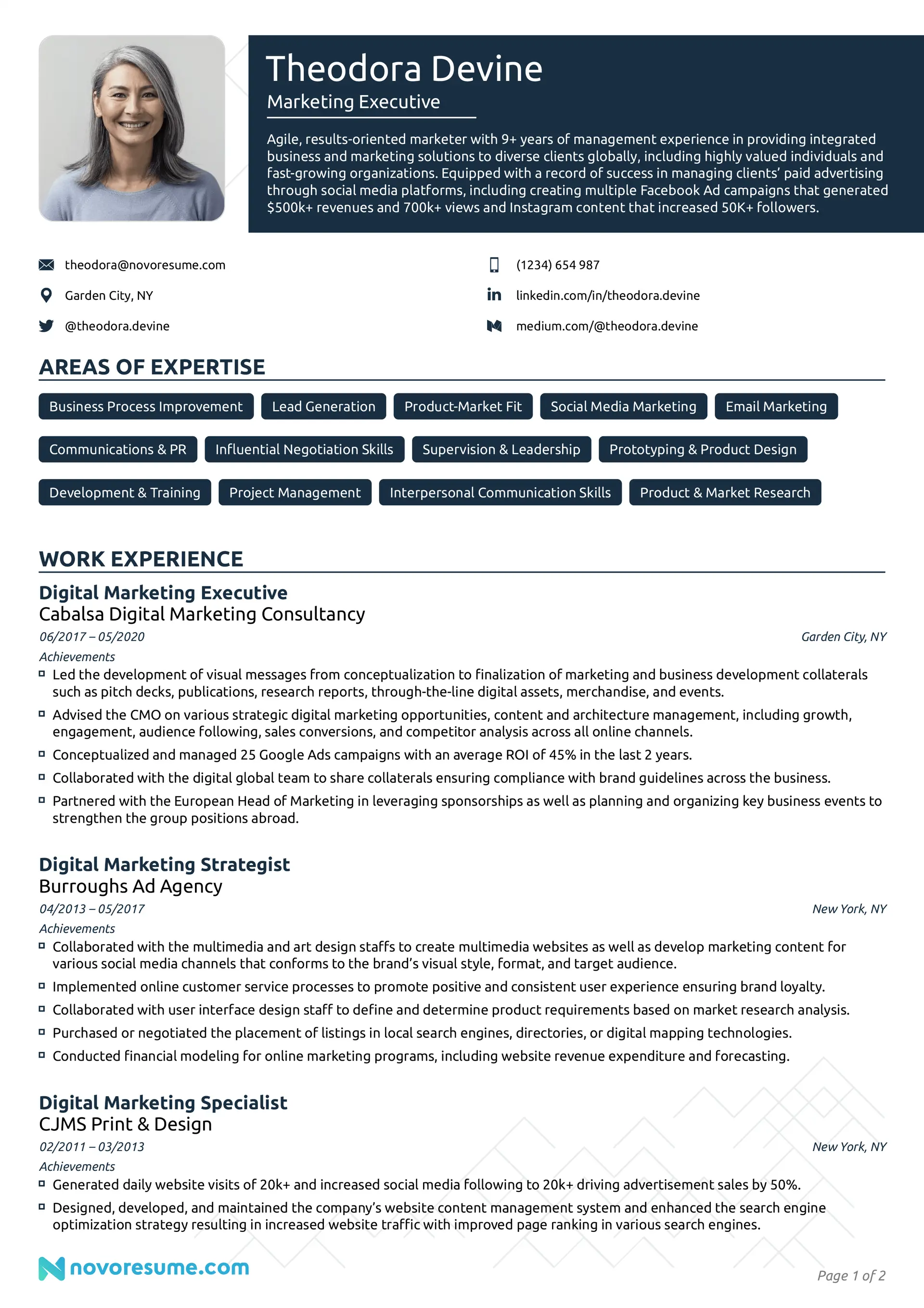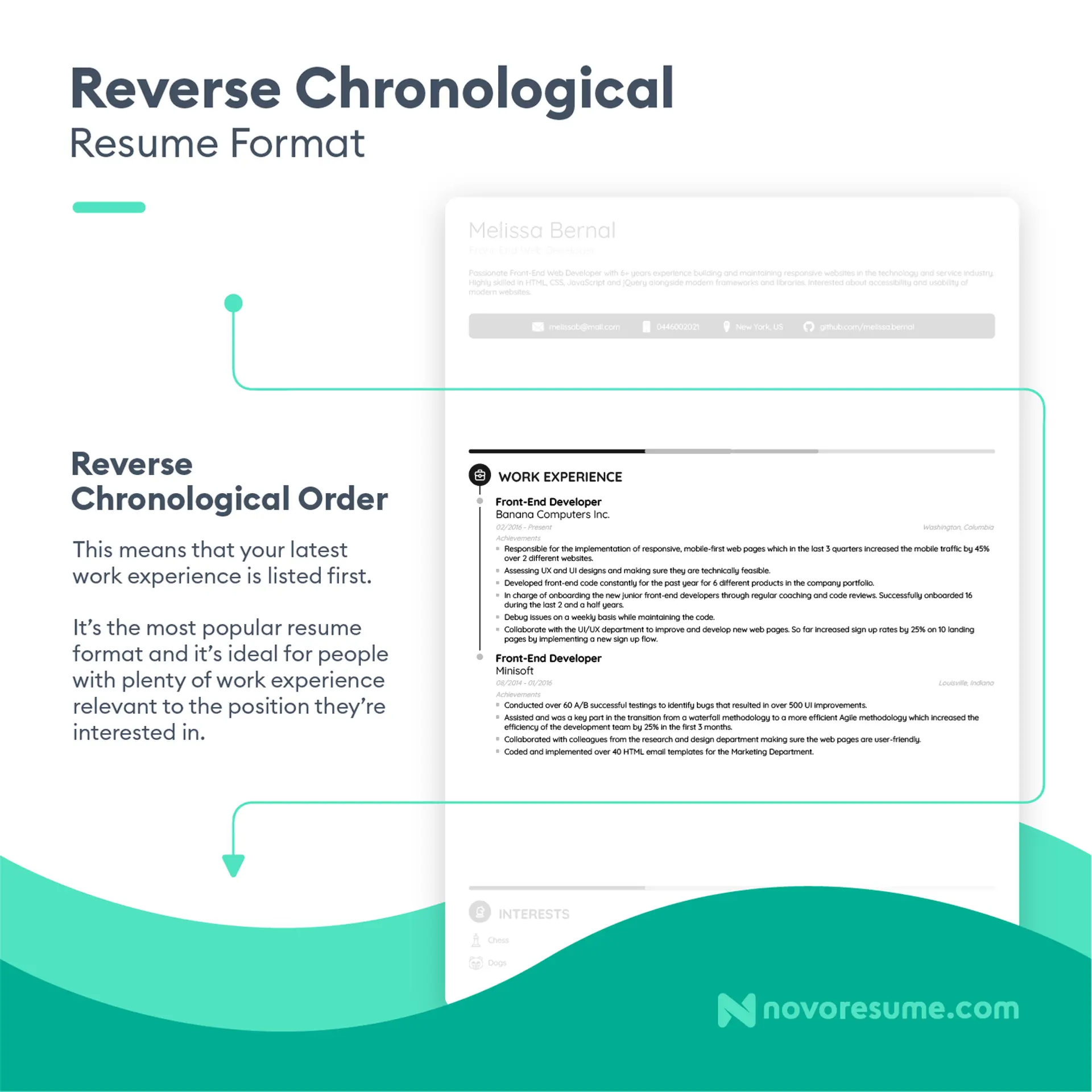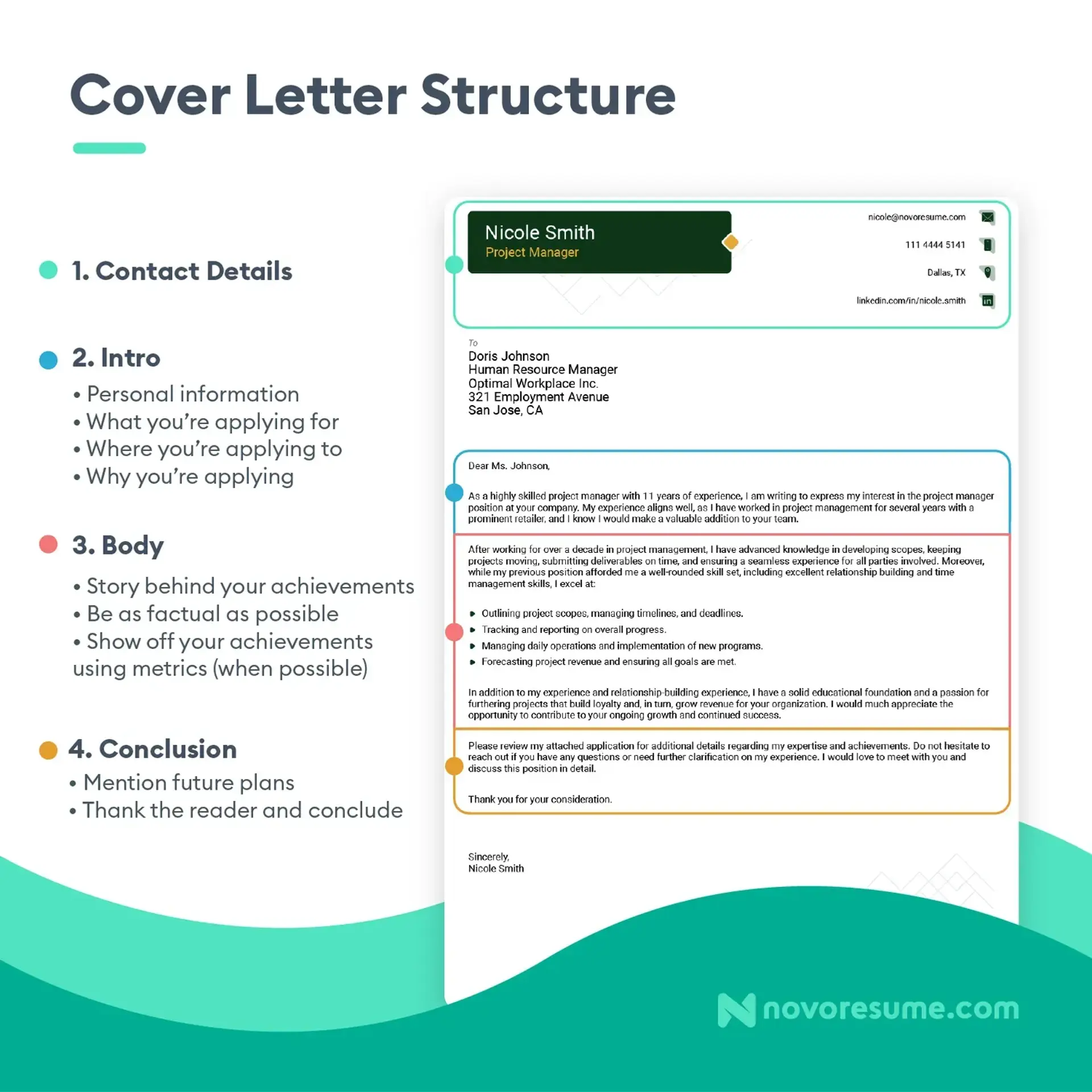
Being in charge of entire departments comes with a whole set of advantages - high impact, lots of responsibilities, interesting work, high pay, and so on.
Being an executive, though, does not mean you get to skip out on the job search process. You still need to create an executive resume and cover letter and apply for jobs.
And creating an executive resume comes with its own special types of hurdles.
Most conventional resume-writing advice does not apply here, leaving you with a ton of questions:
- With so much work experience under your belt, how can you make your executive resume as impactful as possible?
- Do you limit yourself to one page (which is the industry standard), or can you go over it?
- How detailed does your work experience have to be, and do you include positions from a decade back?
In this article, we’re going to answer all these questions and more!
To help you write the executive resume, we’ll cover:
- How Is an Executive Resume Different?
- How to Write a Compelling Executive Resume in 9 Steps
- 17 Relevant Skills for Executives
And more!
Executive Resume Example
Before we dig into the steps you need to take to create a convincing executive resume, let’s cover an example, so you know what it looks like:

The executive resume example above does everything right, including:
- Reverse-chronological resume format. The executive resume example above uses the reverse-chronological resume format to highlight this executive’s impressive work experience.
- Attention-grabbing resume summary. This executive resume example contains an impressive resume summary that emphasizes the candidate’s passions, strengths, and industry-related achievements.
- Focus on work achievements. The executive resume example above highlights the candidate’s most noteworthy achievements, which helps them stand out from other candidates only listing their responsibilities.
- Concise education section. This executive resume example doesn’t go into too much detail in the executive’s education section and instead simply lists the candidate’s most recent and relevant degrees.
- Good use of bullet points. This executive resume example uses bullet points to structure and present information, making the resume well-structured and easy to read.
- Well-structured skills section. Instead of listing all skills in one column, this executive resume example only includes the most relevant skills for the executive position and divides them into soft and hard skills.
- Certifications. The executive resume example above lists all of the candidate’s industry-related certifications.
- Additional sections. This executive resume example includes the candidate’s proficiency in foreign languages and their memberships to help them stand out from other candidates with similar work experience and education.
How Is an Executive Resume Different?
Executive positions are nothing like normal jobs, so it only makes sense for an executive resume to be different from a normal resume too.
But what exactly are those differences? Here are the most important ones you should know about:
- Resume length. As an executive, you probably have much more work experience than your average candidate. As such, you don’t have to fit it all on one page; as a rule of thumb, the executive resume can be two pages, with a maximum of three.
- Data-focused achievements. The last thing recruiters want to see in an executive resume is a list of your responsibilities. If you want to stand out from your competitors, you have to show exactly how you improved the company, optimally by providing data and evidence.
- Conventional format. If you’re applying for an executive position, it’s your resume content that should impress recruiters, not its format. Meaning, that although your executive resume should be well-organized, with ample white space, and with impeccable grammar and spelling, a simple, conventional, black-and-white design should be more than enough. As an executive, there’s no need to go overboard with fancy fonts and creative designs.
- Tailored to the position. Most executives - and especially the senior ones - have a rich work history that could probably fill out more than three pages. That, however, would be counterproductive (both for you and the hiring manager). So, the key here is to tailor your work experience to the target position. Yes, you might have had amazingly valuable work experiences as a team lead from twenty years back, but unless they’re super relevant for the position you’re applying for, you might as well leave them out of your resume. As a rule of thumb, don’t go further back than your last 15 years of employment on your executive resume (some exceptions may apply).
- Selected achievements. Yes, you’re an executive. But you’re also competing against other executives with plenty of achievements. To make your achievements stand out, add a Selected Achievements section right below your resume summary and list 3-4 accomplishments you’re especially proud of (and don’t forget to back them up with hard data).
How to Write a Compelling Executive Resume in 9 Steps
Now let’s go over each section of a successful executive resume, step by step:
#1. Format Your Executive Resume Right
How your executive resume looks is just as important as what it contains. After all, before you impress recruiters with your achievements, you have to get them to read them.
A messy, cluttered resume, however, might just have the opposite effect.
This is where formatting comes in!
The first thing to know is that the reverse chronological format is the most suitable for executives among the three most popular resume formats (the other two being the functional and combination formats).
That’s because it is both the most popular among recruiters and the most suitable for candidates with a lot of work experience.
Here’s an example of the reverse-chronological resume format:

Additionally, make sure that you follow these layout tips:
- Use clear headings to identify the sections in your resume (e.g. H2 or H3). Alternatively, use a bigger font size for your headers and bold them.
- Choose the right font style and size to ensure your executive resume looks professional. For example, Overpass is a formal and classic font perfect for executives in conservative industries.
- Don’t forget to save your resume as a PDF file (unless specifically requested to deliver it in another format). PDFs remain the same no matter the device or Operating System used to view your resume and look much more professional than, say, MS Word files.
Use an Executive Resume Template (& Save Time on Formatting)
Creating a compelling executive resume from scratch can take you hours, especially if you’re using outdated tools like Microsoft Word.
And as a busy executive, time is something you don’t have.
Want to create a well-designed, eye-catching resume within less than 5 minutes?
Use one of our resume templates!
You can choose among 8 free resume templates - executive resume template included and 8 Premium templates.

With Nóvóresume’s free resume builder, you get to skip out on all the resume formatting hassle and focus on what matters - the resume contents.
#2. Add Your Contact Information
The contact information section on a resume is as straightforward as it gets, so you might as well get it out of the way first.
That said, this section is as essential as it is straightforward, so make sure to double and triple-check that it contains no typos.
After all, you don’t want a recruiter not to be able to contact you just because of a typo on your phone number.
Here’s what this section must include:
- First and last name.
- Professional title.
- Updated phone number.
- Email.
- Location.
Additionally, you can also include your LinkedIn profile’s URL and a link to your personal portfolio or website, if you have one.
The same goes for your personal website or portfolio, which can effectively give recruiters a more in-depth look at who you are and what your strengths are.
💡
Quick Tip
87% of recruiters check candidates’ LinkedIn profiles during the hiring process. So, we’d recommend optimizing your LinkedIn profile to reflect your executive profile and achievements!
Here’s an example of an executive resume’s contact information section:
Contact Information Example
Michelle Larkins
Chief Financial Officer
michelle@novoresume.com
123-123-2233
Silicon Valley, California
#3. Write an Attention-Grabbing Resume Summary
The resume summary is among the first things recruiters notice and it serves as a short intro to your professional profile and, specifically, the highlights of your career.
Typically, here’s what this 2 or 3-sentence long paragraph includes:
- Your experience
- Your skills
- Your professional background
- Your accomplishments
Nailing your resume summary is a must if you want recruiters to dig deeper into your executive resume. Just remember to keep it short and sweet with some of your most noteworthy achievements and notable skills.
Here’s an example of a great executive resume summary:
Executive Resume Summary
- CMO with 7+ years of experience in developing and overseeing promotional marketing campaigns. Coming from a long career in public affairs and digital marketing strategies, I am now Executive Vice President at NewEast Inc. Winner of the 2021 Global Best of the Best Effie Award.
#4. Add a Selected Achievements Section
If you were to choose, you’d probably want recruiters to notice your career highlights right off the bat, instead of having to look for them.
Well, as an executive, you can do just that by adding a Selected Achievements Section.
Positioned between your resume summary and your work experience, a Selected Achievements section can give recruiters a quick preview of your most noteworthy achievements and get them to look deeper into your executive resume.
As such, think about the highlights of your career - between two and five achievements you’re particularly proud of - and list them in bullets on your executive resume.
Here is an example of an executive’s Selected Achievements section:
Selected Achievements:
- Was the youngest person to be promoted to CFO in the company in 40 years.
- Led company-wide initiatives that won me the Strategy Execution Award and the Young CFO of the Year Award.
#5. Focus Your Work Experience Section on Your Achievements
The work experience section is going to be the highlight of your executive resume.
This particular section is exactly where you show off years worth of experience and achievements.
Here’s how you should do it:
- Start with your current or most recent position and go backward from there.
- For every work entry, list your professional title, company name, the dates you worked there, and 4-6 of your achievements in bullet points.
- The further back you go in your work history, the fewer achievements you need to list. For jobs going 5+ years back, you can save resume space and just list 1-2 of your most notable accomplishments.
- When listing your achievements, make sure to make them as quantifiable as possible. For example, instead of writing “improved company stock,” you can write “increased company stock by 15% within a one-year period.”
- Give your work experience section an active voice by using action verbs such as “achieved,” “managed,” “increased,” “led,” “emphasized,” etc.
- Tailor your work experience section to as many jobs as you’re applying for. So, if you’re applying for more than one position, use your diverse work experience to customize your resume based on the job you’re applying for, as opposed to submitting a one-fits-all executive resume.
It’s actually pretty simple, right? Here’s a concrete example of an executive’s work experience section:
Work Experience Section for Executive Resume
Chief Human Resources Officer
XYZ Inc.
02/2018 - 06/2022- Successfully led teams of +200 employees in 4 locations.
- Updated the company’s talent acquisition strategy, leading to a 20% increase in the number of people hired in 2021.
- Improved company inclusion policies, which resulted in winning a Forbes diversity award.
- Changed up the company’s hiring process, paying particular attention to positive discrimination policies, resulting in hitting company diversity quotas for the year.
Human Resources ManagerZYX Inc.02/2013 - 12/2017- Improved company hiring rates by 47% by establishing a more inclusive hiring process.
- Applied new interview questions to the hiring process, making the hiring process more effective by hiring employees that are more suitable to the company culture.
#6. Briefly Mention Your Education
Your education should come right after your work experience section. This section is just as important as your work experience, though it doesn’t require that you go into too much detail.
After all, if you already hold an executive position, you probably already have a lot to show through your professional achievements.
Here’s what you should include in your education section to make it stand out from the crowd:
- Begin with your most recent degree and include the institution’s name and location, as well as the years attended.
- If you hold more than one Master’s or advanced degree, also include those in your education section.
- Leave your high school education out of your executive resume.
Here’s what this looks like on an executive resume:
Executive Resume Education Section:
Ph.D. in MarketingHaas School of Business - University of California, Berkeley2012 - 2014MSc in Innovation & Marketing ManagementStrathclyde Business School - University of Strathclyde, Glasgow2011 - 2012
#7. Include Your Executive Skills
It probably comes as no surprise that executive positions are highly competitive.
This means that you need to make sure that, in addition to your work experience and education sections, other sections also need to stand out, including your skills, certifications, interests, and awards.
In light of this, here’s the best way to list your skills on your executive resume:
- List your soft skills and hard skills. Include both CEO skills (e.g. leadership) and management skills, as well as industry-related skills here (e.g. if you’re into finance, that would include all your finance-related skills).
- Pay close attention to the job description of the position you’re applying for. Do any of the keywords indicate what skills are required for the position?
- Make sure to include the skills mentioned in the job description on the skills listed on your executive resume (as long as you actually have them).
17 Relevant Skills for Executives
Here’s a list of relevant skills for executives that you can use on your executive resume:
- Senior Leadership Skills
- C-Suite Communication & Presentation Skills
- Change Management
- Emotional Intelligence
- Strategic Thinking
- Decision Making
- Delegation
- Employee Development
- Adversity Management
- Collaboration
- Active Listening
- Communication Skills
- Empathy
- Interpersonal Skills
- Conflict Management
- Negotiation
- Project Management
#8. Add Optional Resume Sections
The difference between great and perfect lies in the details - such as taking advantage of some optional sections that can take your executive resume to the next level.
Specifically, the following sections can help you stand out from other executives applying for the same position by highlighting your individuality and the diversity a truly great executive needs:
- Awards, especially anything job-related.
- Memberships, for example, Member of the Chicago CEO Club.
- Foreign languages, particularly those you’re fluent in.
- Certifications, such as Project Management Professional (PMP) or Accredited Business Communicator (ABC).
- Personal achievements, including successful personal initiatives and noteworthy recognitions outside your industry.
- Hobbies and interests, anything from fitness to reading books.
#9. Don’t Underestimate the Power of the Cover Letter
Attaching a cover letter to your application is just as essential as creating a powerful executive resume.
Specifically, a cover letter is important because:
- Recruiters expect a serious job application also to include a cover letter, even if they skip reading it.
- It lets you go into more detail about your skills and qualifications.
Here’s how to write a cover letter that is on par with your executive resume:
- Start your cover letter with an impactful introduction.
- Use the body of your cover letter to offer a more in-depth explanation of your executive skills and managerial experience.
- To enhance your executive resume, include skills and achievements that support what you’ve stated there.
- End your cover letter with a call to action.
To give you a more concrete picture of what we mean, here’s what the structure of a cover letter should look like:

💡
Quick Tip
Want to learn more about cover letter writing? Then check out our guides on cover letter tips and common cover letter mistakes!
Key Takeaways
And that’s a wrap!
By now, you should be ready to nail your executive resume! Before you go, here are the most important points we covered in this article:
- Your executive resume must include your contact details, a resume summary, a work experience section with your most notable achievements, your education background, and a skills section.
- Additionally, your executive resume can contain some extra sections, such as certifications, awards, memberships, etc.
- Choose the chronological resume format to build your executive resume.
- List relevant quantifiable achievements under each entry in your work experience section.
- Use a ready-made template to save time and effort when you’re writing your executive resume!
